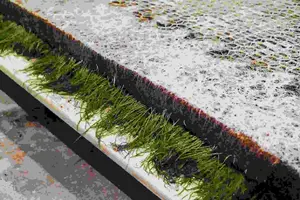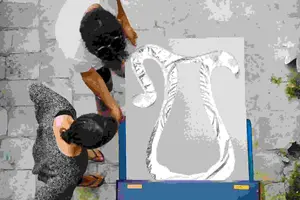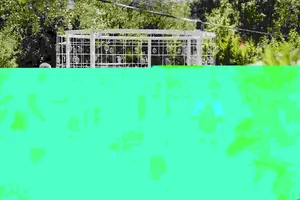It is the seventh 12 months of Jerusalem’s Design Week, and that stability has been evident in the breadth and scope of this 12 months’s designs and works created by greater than 100 Israeli and worldwide artists and designers.
Called “Conserve,” or “HaShmura,” a Hebrew time period normally used for nature reserves or a reservoir, the week-long occasion, ending Thursday, has been going down primarily on the Hansen House and the Bezeq Building, and together with a number of different areas as properly: the Jerusalem Theater, the Islamic Art Museum, the Bible Lands Museum, and Beit Alliance.
Design Week mimics comparable exhibitions and efforts held in different nations, however is wholly a product of Jerusalem, funded by The Ministry of Jerusalem and Heritage and the Jerusalem Development Authority, initiated by Hansen House and managed by Ran Wolf Urban Planning and Project Management.
It can also be the central, annual occasion for Hansen House, the historic leper hospital that was become a middle for design in 2011 by town of Jerusalem. What started as a small, comparatively minor design exhibition was expanded three years in the past into a extra worldwide occasion that examines conditions distinctive to Jerusalem and Israel, but related to the worldwide neighborhood and world points.
This 12 months’s week-long present has targeted on conservation and sustainability, a focus that weaves its method all through the restored gardens, rooms, and courtyards of the previous Jerusalem leper colony that's itself a image of conservation and restoration.

The fashionable tackle avenue indicators and posters as a part of ‘Pro Jerusalem – 100 Years of Conservation’ at Design Week Jerusalem 2018 (Courtesy Dor Kedmi)
The Hansen House exhibition opens with “Pro Jerusalem,” a telling have a look at 100 years of conservation, hearkening again to Ronald Storrs, the primary British governor of Jerusalem who based the Pro-Jerusalem society, charged with creating and selling town’s picture, a idea that had not beforehand existed in pre-state Palestine.
There are artifacts from that interval, together with sewer covers, items of Jerusalem stone and Armenian ceramics, a part of Storrs’ efforts to import artisans to the holy land, and create a distinctive look for the holy metropolis.
The exhibit strikes on to the works of six younger designers who replicate on town’s subsequent 100 years, with avenue lighting made out of Jerusalem stone, signage in English, Hebrew, Arabic and French — the newest language to hitch Jerusalem — cleverly pointing to the present points of faith, politics and society, a number of extra present manhole covers and ceramics for this point in time.
Another well-liked exhibit at Hansen House is “The Matchmaker,” which brings collectively conventional craftspeople from Jerusalem with younger industrial designers.
A workshop of blind brush-makers from the Old City labored with one designer to create delicately tinted incense brushes and pots. A basket-weaver and one other designer made distinctive, woven-bottomed material procuring and purses. A metallic craftsman and his design associate created delicately reduce tables and family items, cleverly crafted with hidden letters and shapes.
“These are things that can only happen here, in Hansen or the Old City,” stated Anat Safran, creative director of Design Week. “I’m always surprised by the crowd here, all kinds, and it’s a microcosm of the conflicts and communities. It’s like a lab.”
The Hansen House opened a number of of its ante buildings and courtyards for this 12 months’s Design Week, together with the previous laundry of the leper colony, which homes the “Applied Nature” exhibit, the place a number of artists created works impressed by nature, that query the place of human design and bioengineering.

An intricate root sample grown on the underside of a piece of sod at Jerusalem Design Week 2018. (Courtesy, Dor Kedmi)
Dutch designer Diana Scherer spent the previous couple of weeks — “It was stressful seeing if it worked,” stated Safran — weaving plant roots into an Arabesque design underneath a piece of sod, a system of roots that can ultimately separate from the grass, a method she created.
Then there’s the Digital Garden of Maya Ben David, who scans flowers and reprints them with a 3D printer and Luca Or’s paper anemones, delicate recreations of the beloved Israeli spring flower.
The interior courtyard of Hansen homes the “Granary,” wanting on the many kinds of grain that when flourished in the area, hung in a spiral of sheaves. Nearby, one other artist created the Balloon Factory, a workshop of silver, Mylar balloons reduce in shapes harking back to the previous and way forward for Israel, from pomegranates and scythes to conventional Palestinian keys, donkeys, and the dual tablets carried by Moses.

Cutting Mylar balloons of great shapes, together with certainly one of an historical ceramic jug, at Jerusalem Design Week 2018. (Courtesy, Dor Kedmi)
Back in the entrance gardens of Hansen, the Onya Collective created 4 fields analyzing mankind’s relationship with nature.
A stroll alongside the primary sidewalk presents a have a look at a round pantry of petri dishes holding heritage seeds, creating an archive of what was as soon as planted. Across the best way is a sentry of conceptual scarecrows whose garments are slowly dyed completely different colours by a trickle of dyed water from a system of acquainted black tubing and a zen backyard for discovering the wonders of calm and serenity.
These ideas of conservation and nature are carried over on the close by Bezeq Building, as soon as owned by the phone firm and now used in half by Hansen, the place a assortment of reveals vary from the hands-on to extra conceptual.
The principal exhibition for Design Week, “The Human Conservation Project,” created by Safran and head curator Tal Erez, takes a have a look at the human effort to preserve its personal existence, by means of a mixture of artists from Israel and overseas.
There is the video imagery of an Australian effort to create a physique that may maintain automobile accidents, the Alternative Limb Project that designs prosthetics, equivalent to a vine or a synchronized hand, a knitted boyfriend doll, and hug machine or thermal rendering for viewing a full human picture.

Examining petri dishes of heritage seeds in an exhibit about nature and conservation at Hansen House, created by the Onya Collective at Jerusalem Design Week (Courtesy Dor Kedmi)
“Technology allows us to do some pretty radical things in this race against time,” stated Erez. “It’s a question of how far we’re willing to go.”
One of the most well-liked reveals in the Bezeq area is “A Commonplace Book of Time,” a set of data machines that transcribe snippets of data, whether or not drawings, comics, or textual content, onto clean notebooks set in place by the viewers.
While Design Week ends on June 14, one exhibit, the “Flag Exhibition” that features 29 Israeli and worldwide artists reevaluating the function, that means, and look of Israel’s flag, will stay open by means of June 28 on the metropolis’s Beit Alliance close to Mahane Yehuda.